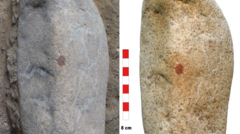The discovery of a rock with a human fingerprint and a red pigment dot signifies potential Neanderthal creativity, challenging our understanding of their cognitive abilities in relation to art.
### Neanderthal Artistry: Discovery of Ancient Fingerprint Sparks New Dialogue

### Neanderthal Artistry: Discovery of Ancient Fingerprint Sparks New Dialogue
A groundbreaking find in Spain suggests Neanderthals may have engaged in artistic expression 43,000 years ago.
The findings, located in the San Lázaro rock shelter in Segovia, have ignited discussions among scientists regarding the symbolic and artistic capabilities of Neanderthals since the evidence points towards intentional creation rather than mere coincidence.
In a significant revelation, scientists in Spain have unearthed what they describe as the oldest complete human fingerprint from an ancient Neanderthal. This discovery was made on a pebble, which seemingly has markings resembling a human face, suggesting that Neanderthals might have produced early forms of art. The research indicates that a Neanderthal male around 43,000 years ago dipped his finger in red pigment to create a dot on the rock, discovered at the San Lázaro rock shelter in Segovia.
The precise positioning of the pigment raise questions about Neanderthals' capacity for abstract thinking, and the research contributes to the ongoing discourse around their artistic abilities, according to co-author María de Andrés-Herrero from the University of Complutense in Madrid. The excavation process began five years ago, with a pivotal find occurring in 2022 when they recovered the stone buried beneath sediments associated with Neanderthal habitation.
Before confirmation, the research team was perplexed by the stone’s unique attributes, particularly the presence of a red dot in the center that evokes the visage of a human face. Initial uncertainty regarding whether the dot was produced using ochre, a natural pigment, drove them to consult Spain's scientific police for advanced analysis.
Investigations revealed not only the presence of fingerprints but also implicated that the mark originated from a male adult. However, co-author and archaeologist David Álvarez Alonso cautioned that due to the lack of comparative samples from other Neanderthals, definitive identification remains challenging. Spanish official Gonzalo Santonja highlighted the significance of the find, emphasizing that this pebble represents the oldest known painted portable object in Europe, marking it as a unique artifact attributed to Neanderthals.
Prof. de Andrés-Herrero noted that this discovery constitutes a pivotal argument in the conversation about Neanderthal symbolic capacity, being the first recognized object marked by pigment in an archaeological setting. The context and location of the fingerprint point to its intended use for artistic expression rather than practical utility.
Additionally, researchers concluded that the usage of the ochre was deliberate, as evidence suggests this red pigment was not naturally available in the rock shelter, implying that Neanderthals actively brought it there. In their published paper in *Archaeological and Anthropological Sciences*, the authors argue that the characteristics of the pebble justify its classification as a visual symbol—potentially a piece of portable art, expanding our understanding of the cognitive abilities of Neanderthals in the realm of creativity and symbolism.
In a significant revelation, scientists in Spain have unearthed what they describe as the oldest complete human fingerprint from an ancient Neanderthal. This discovery was made on a pebble, which seemingly has markings resembling a human face, suggesting that Neanderthals might have produced early forms of art. The research indicates that a Neanderthal male around 43,000 years ago dipped his finger in red pigment to create a dot on the rock, discovered at the San Lázaro rock shelter in Segovia.
The precise positioning of the pigment raise questions about Neanderthals' capacity for abstract thinking, and the research contributes to the ongoing discourse around their artistic abilities, according to co-author María de Andrés-Herrero from the University of Complutense in Madrid. The excavation process began five years ago, with a pivotal find occurring in 2022 when they recovered the stone buried beneath sediments associated with Neanderthal habitation.
Before confirmation, the research team was perplexed by the stone’s unique attributes, particularly the presence of a red dot in the center that evokes the visage of a human face. Initial uncertainty regarding whether the dot was produced using ochre, a natural pigment, drove them to consult Spain's scientific police for advanced analysis.
Investigations revealed not only the presence of fingerprints but also implicated that the mark originated from a male adult. However, co-author and archaeologist David Álvarez Alonso cautioned that due to the lack of comparative samples from other Neanderthals, definitive identification remains challenging. Spanish official Gonzalo Santonja highlighted the significance of the find, emphasizing that this pebble represents the oldest known painted portable object in Europe, marking it as a unique artifact attributed to Neanderthals.
Prof. de Andrés-Herrero noted that this discovery constitutes a pivotal argument in the conversation about Neanderthal symbolic capacity, being the first recognized object marked by pigment in an archaeological setting. The context and location of the fingerprint point to its intended use for artistic expression rather than practical utility.
Additionally, researchers concluded that the usage of the ochre was deliberate, as evidence suggests this red pigment was not naturally available in the rock shelter, implying that Neanderthals actively brought it there. In their published paper in *Archaeological and Anthropological Sciences*, the authors argue that the characteristics of the pebble justify its classification as a visual symbol—potentially a piece of portable art, expanding our understanding of the cognitive abilities of Neanderthals in the realm of creativity and symbolism.




















